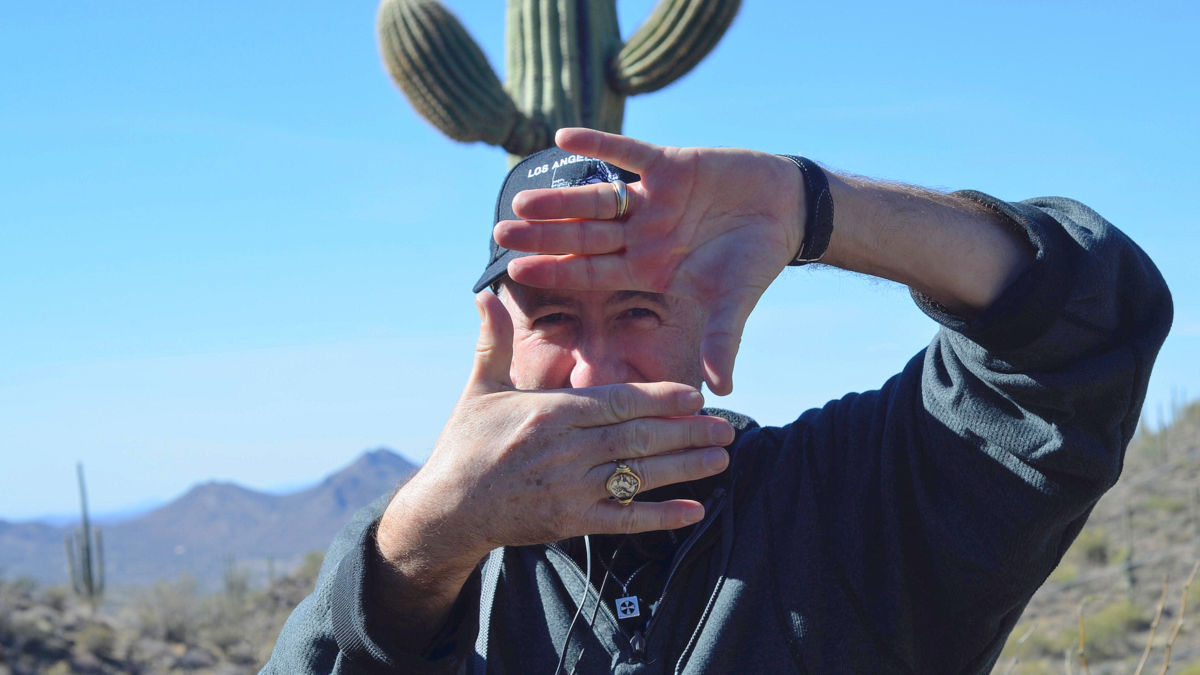
Adrian Carr watched endless American Television as a kid in Australia. At 12, his Dad taught him how to process ‘Black & White’ negatives which led to Adrian studying Photography and Making a Student film titled The Man from N.U.C.L.E. After School, Adrian joined the ABC (Australian Broadcasting Commission) where he worked as an Assistant Editor for 3 years before joining Crawford Productions where he rose quickly through the ranks to become a Premium Editor. Then, he moved to Film House, where he edited commercials. “While at Film House, I edited my first feature length film Harlequin and I got nominated for the AFI award for Best Editing” says Adrian Carr.
I continued editing and worked as 2nd Unit Director on the Box Office hit The Man from Snowy River, which helped establish me as a top editor in Australia then it got me International Recognition. In 1982, I directed and edited the movie Now and Forever starring Cheryl Ladd. In 1989, I directed The Sword of Bushido in Thailand, edited and directed 2nd Unit on the Tom Selleck Western Quigley Down Under. I made the move to Los Angeles from Australia, with my wife and I have concentrated on directing, developing and writing Screenplays.
My work as a Director is akin to a General Overseeing his Army, but one who gets into the trenches with his troops. I delegate to various officers (Departments Heads) who in turn instruct the troops (Crew). I have a Battle Plan (the Schedule and Script) and fight the odds (day to day challenges) to complete the movie on time and on budget. The Producer (King, Queen, President or Dictator) is ultimately responsible for the final delivery of a movie and it is his/her trust in me (the Director) to deliver my Creative Vision of their film.
Watch SOLUS TV Series Pilot – A Mythological Sci-fi Adventure Entertainment for Network Syndication
indieactivity (IA): How do you choose a project to direct? What things do you consider?
Adrian Carr (AC): I need to resonate with the material whether it be epic or intimate. Is the subject matter interesting, is it entertaining, is it thought-provoking?
Why filmmaking? Why did you get into it?
Adrian Carr: Filmmaking has been in my blood from a young age. I sucked at math, but excelled in the arts, drawing, photography and filmmaking so it was a natural path to follow.
Is there anything about the independent film business you still struggle with?
Adrian Carr: For me, the biggest struggle as an Indie filmmaker is to find investors who will take a risk on films without A list actors attached because the first question out of the mouth of a distributor “Who’s in it?” and that causes many investors to shy away from a project.
Can you talk to us about your concept of collaboration?
Adrian Carr: I see collaboration to be essential on any movie especially on a creative level. For me, as a director I am always open to creative ideas suggested by the crew no matter how off the wall they might be. While I have my vision, it is naïve to think that my approach is the only one. Collaboration brings out the best in people and if you cast your crew as well as you cast your cast, they will have your back as challenges arise and help see the battle through to the end.
What uniqueness do you think that female directors/filmmakers bring to film/tv/cinema?
Adrian Carr: Women directors, for me, bring a greater understanding, insightful depth of character and they benefit from being able to multi-task on a set as they do in real life.
When you are offered a project, what things do you put in place to deliver a good job?
Adrian Carr: I first ask what the budget is, will it enable me the creative freedom I need or will I be expected to compromise? I do my research on the producer or company who are going to entrust me with their dollars and try to ascertain if I will have strong producer who knows how to stretch those dollars so they end up on the screen and not on the cutting room floor, or nowadays, the digital trash bin. Surrounding oneself with the best talent available is a smart move for any director. For me, my DP is at the top of my list followed by the Production Designer as these are the two people who are integral to bringing my internal vision to the screen.
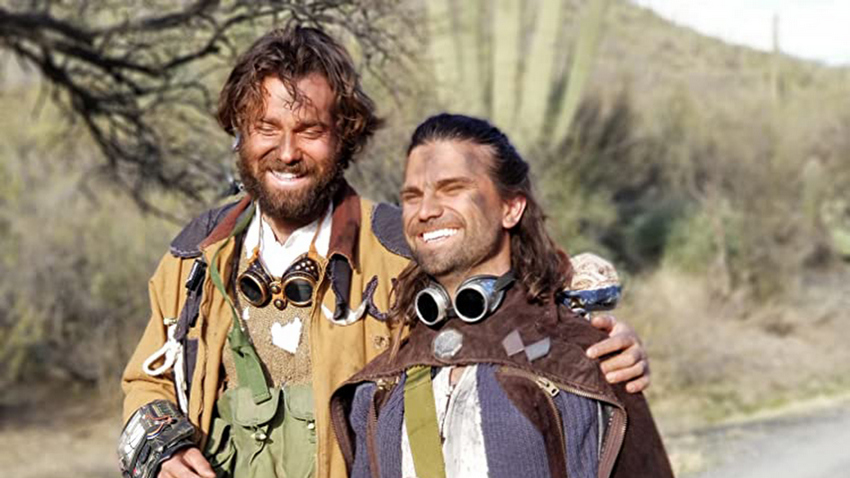
How do you feel about the process of filmmaking as an indie filmmaker?
Adrian Carr: What I enjoy most about indie filmmaking is the freedom to try things without being second guessed or dictated to, and the comradery that comes from working with a smaller crew; all being in it together.
What goes into choosing an actor for a role? What do you look for?
Adrian Carr: What I look for when casting actors is chemistry, inventiveness and personality. Do they look the part? Casting against type can be a double-edged sword, but sometimes worth the risk. Is an actor open to taking direction or not? In the case of SOLUS the lead cast were locked in already, two of them were also the writers and producers while Danene Montella was cast as Hope, but I knew our end sequence in Mission Control needed gravitas brought to it and was thrilled when Bruce Locke and Julia Ling, agreed to come on board.
Pre-Production
I had cast and directed Jacob, in a short I directed and he asked me to get involved in the production. Jacob and Jordan had written a very ambitious story designed to be shot on Jacob’s parent’s 20-acre property in Arizona and had already raised money via an Indiegogo campaign. It was at this point my wife, Rosemary Marks (Thirteen), an experienced Producer offered her services. Rosemary prepared a detailed Budget so Jacob and Jordan could get a sense of what would be needed as we moved into pre-production itself.
My first goal was to secure a Cinematographer who I knew and could trust would be able to help me pull off this tall order. I met and spoke at length with Ross Berryman, (For All Mankind Seasons I and II) to determine how to shoot without lighting other than the Sun, since we would not have the manpower or be able to afford to light any night scenes.
We worked with costume designer Camara Rauen to create a steampunk Fashion Style. Corey Milligan, a friend of Jacob’s from Texas, created many of the cool specialty hand props as well as the two soldier outfits in the finale.
Ariel Stafford, a Makeup Artist in Phoenix would pull double-duty as both hair and make-up. I checked out her work on Instagram and immediately knew she could meet the challenges of SOLUS.
Poor Sound is the tell-tale sign of most indie films and having a top location sound mixer is a must on any movie production. They’ll save you countless Dollars in post-production and we lucked out when Kirbie Seis (Swiss Army Man) joined our production team. I didn’t want to have any sounds that reminded me of Earth, no traffic, no birds or crickets et al, just dead quiet. Despite light aircraft arriving constantly for a golf tournament in Phoenix, Kirbie delivered such clean audio that the only Wild Lines we recorded were to clarify some story points after we completed the edit.
Rehearsals were in my driveway and backyard with Jacob, Jordan and Danene Montella. We would meet to block out the main dialogue sequences at the campsite, and try different blockings and camera angles.
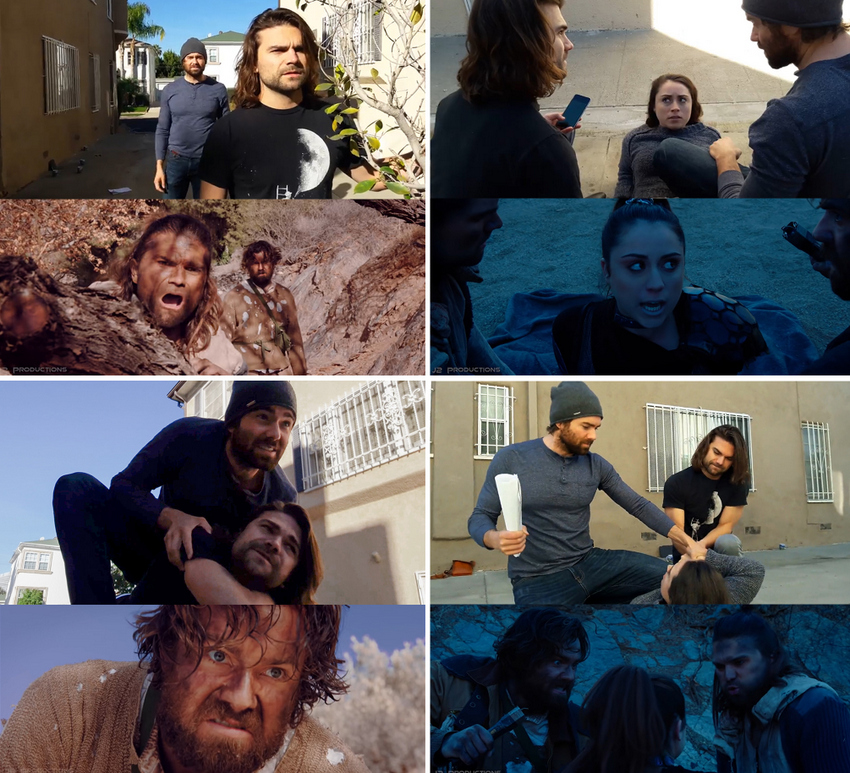
As the start of production loomed, I called in a favour from a close friend, Thomas Hencz, who owns T-Stop Camera Rentals in Hollywood. Timing was everything and Thomas went above and beyond the call of duty to provide us with the Arri Alexa Mini camera, lenses and accessories, Ross had requested that enabled us to achieve the highest quality possible for SOLUS. I met with Jacob and Jordan in Arizona a couple of times to scout locations and work out production logistics so I could confidently storyboard the sequences once back in L.A. Rosemary could set about recruiting our micro-crew from Phoenix and LA.
Rosemary brought on Tamara McDaniel to Line Produce the shoot in Arizona. Being a Phoenix local, Tammy was instrumental in helping us find some key personnel namely our 1st Assistant Camera and Grips who filled in after a minor mishap side-lined our Key Grip for two days.
Rusty Case, also a Phoenix local, was my First Assistant Director. The SOLUS shoot was very complex for an Indie film, not only did Rusty have to schedule the usual shooting day, but had also to factor in the enormous amount of plate shots, VFX elements, on-location green screen shots and drone shots… all in 5 x 6-8 Hour days. Needless to say, we made our days.
Miranda Calamity was my script supervisor and had the daunting task of collating various shot elements as well as keeping an eye on any continuity issues. The fact she is also an editor helped Miranda comprehend the complexity of the shots needed and how they all fit together.
Once the 5-Day Shoot in Arizona was completed we still had to prep two major green screen sequences, and some additional elements to shoot in Hollywood. Our green screen postage stamp size stage was less than ideal, but I was able to put my experience of Filming Live-Action Green Screen sequences for computer games, to great use. We utilized every available inch of the stage to block the actors so they could be seamlessly integrated into the 3D world yet to be created from the set designs I had drawn. We managed to film 9 minutes of screen time in 10 Hours under these challenging conditions due in no small part to our experienced cast and crew, some solid planning and a lotta luck.
Post Production
Editing on Solus; I completed the first assembly edit in 2 Weeks but that was ONLY the beginning that stretched into 6 months.
I could devote an entire chapter to the post-production on SOLUS. The financial stress on Jacob and Jordan was high, but they both stepped up after seeing the rough edit and said we had to make it the best it can be. Without going into details, except to say dealing with the VFX and sound post-production had many challenges. These challenges ended up pointing us in the right direction, however and everything ended up turning out better than we could have imagined.
Including our score from Marcello de Francisci, that was pure GOLD.
After pre-screening the first edit of the film to some people, it became obvious we needed to provide additional clarity for the story we were trying to tell. Jacob and Jordan had an idea of a new opening that involved a stylized burning candle with two out of focus bodies talking in the shadows since they looked completely different to when we filmed and that we could shoot it in my garage. When I discovered the scene would run 2 ½ minutes I knew it would not sustain interest so I figured out a way to create a visually compelling sequence and we were very pleased with the end result. They say “necessity is the mother of invention”.
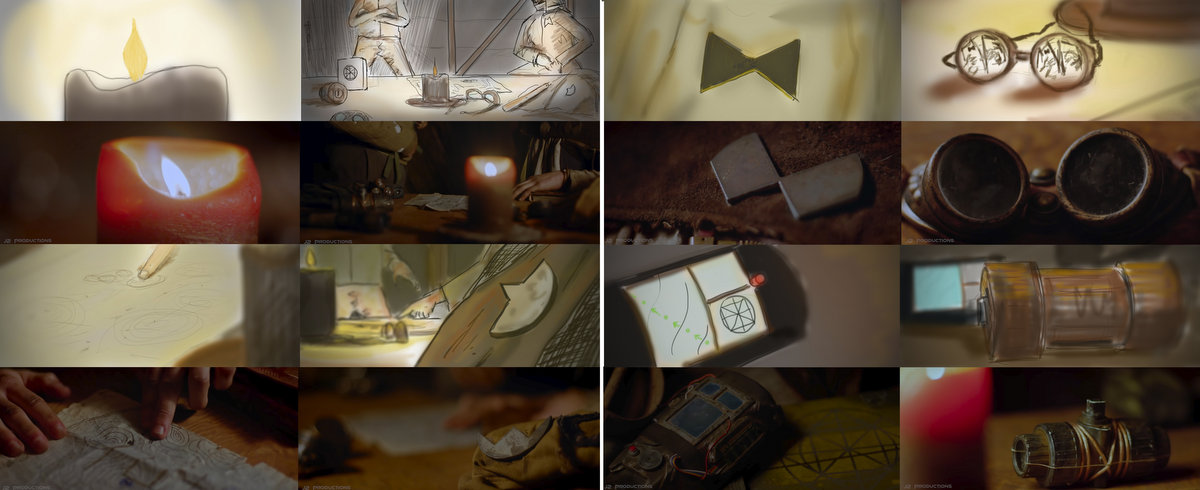
For the next 6 months we continued to fine tune the edit while, under the guidance of two very experienced VFX Supervisors, outsourced shots containing visual effects to vendors around the globe.
Jacob and Jordan took on the role of post-production Supervisors. You have to remember, these guys held down part-time jobs and poured every spare second and dime into their baby. They learned Adobe After-Effects and contributed to an enormous amount of shots, specifically all the data screens in the spaceship and Mission Control facility among other individual effects. This is what is demanded of true independent filmmakers.
A new Sound Design crew, Polar Sound came onboard and were on the same wavelength with us. The end result a 5.1 Surround Sound is awesome if one has the capability to play it.
When our 3D Set Designer in Vancouver bailed on us Matt Faulkner came to our rescue. Between his major gigs he built us massive 3D Sets for the interior of the Cereus 6 Spacecraft and Cereus Mission Control Room.
There are 500+ Visual Effects in SOLUS can you tell us how you achieved this?
AC: Going into SOLUS we knew there would be many shots that required visual effects. Many complex, some simple. Initially Jacob and Jordan researched many VFX companies. These companies/individuals are located all over the world so it was an intense undertaking to try and isolate the experienced from the novices.
The delay allowed us to rethink our approach and with advice from a couple of highly experienced VFX supervisors here, we farmed out individual shots to separate artists each specializing in the required effect. We calculated there were over 500 visual effects to be completed and sent the work out to bonafide VFX professionals working REMOTELY around the world in Russia, Poland, Ukraine, Canada, Costa Rica, Australia, Los Angeles, San Francisco and New York. Since we had no actual deadline, these artists were able to slot our work in between their full-time paying gigs and work for a reduced fee.
The sequence I knew was most important for me to nail was the need to immediately convey to an audience we were not on Earth. At the start of the story we have a traveling aerial shot of our two heroes as they reach the top of a mountain and look out across a valley to a crumbling walled city with two suns hanging in the sky.
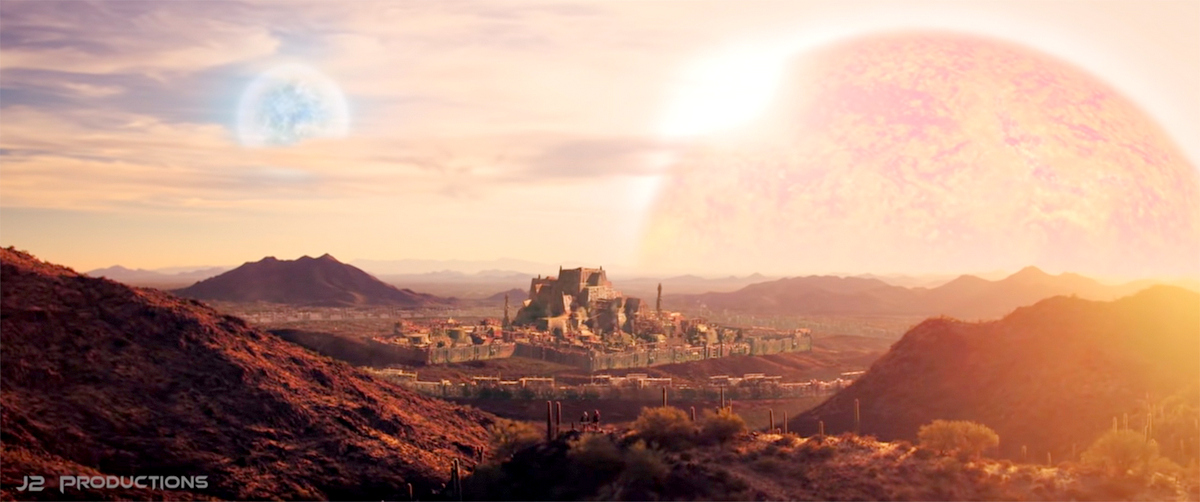
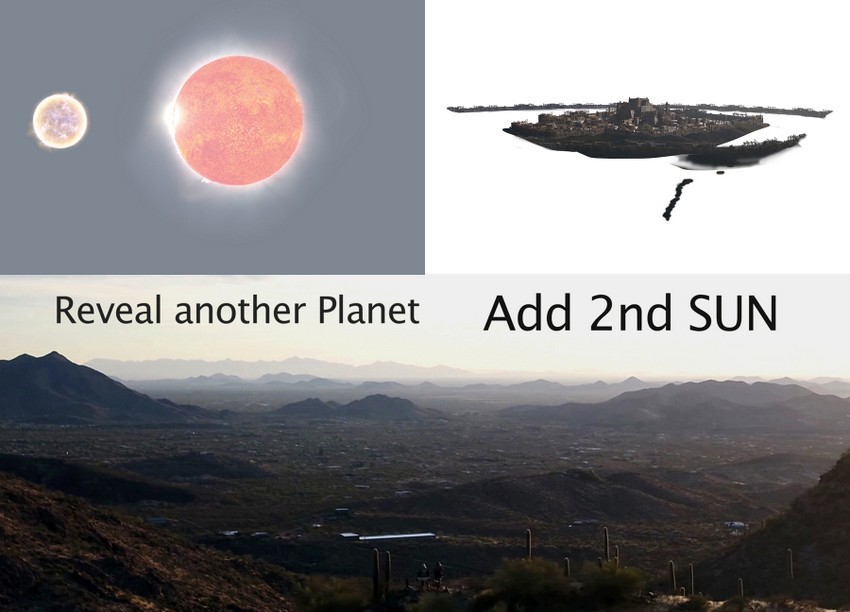
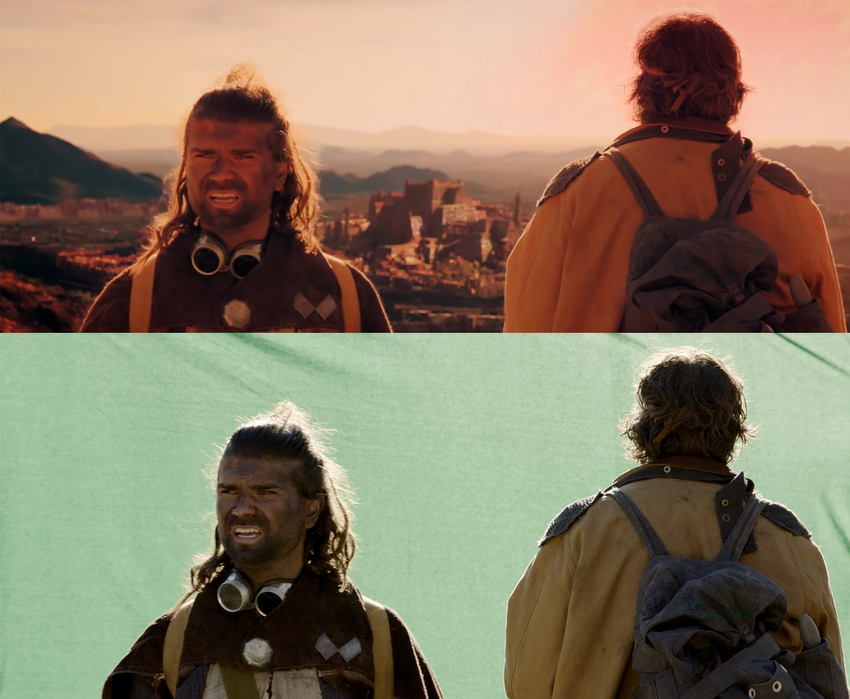
It was a crucial shot and David Edwards, in Vancouver, created a matte painting of the walled city element and two suns. Snow Dog FX seamlessly composited this into the drone footage, removed all the foreground buildings, added smoke, atmospheric haze and dust particles. Something made more difficult because of it being a moving aerial shot, and something usually reserved for big budget sci-fi shows
When I saw their first pass, I knew we had a movie and could breathe a sigh of relief.
The other key visual effects was our AP77 aka the Hawk. It was a major character in the film and needed a personality of its own. Enter VFX wizard Andrey Litke who rigged/animated the 3D Model, texture mapped it, created the invisibility cloak, and invented its protective shield. Andrey’s expertise was also invaluable in the compositing of the final green screen scene in the Cereus Control Facility on earth.
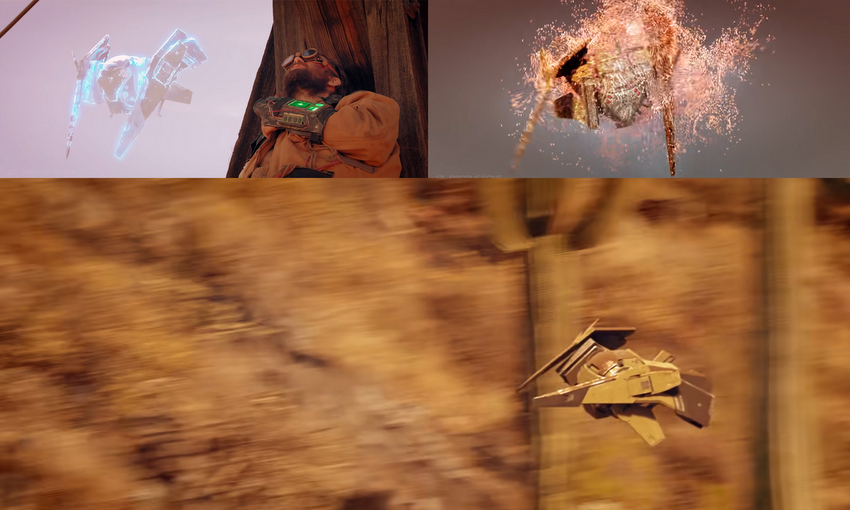
Providing visual uniformity to the whole project was colorist Peter Misztal Choi in Poland.
What was your favorite experience working on the SOLUS production?
AC: Aside from the cast and crew’s infectious enthusiasm for SOLUS and reconnecting with Ross, my favorite experience was working with music composer Marcello de Francisci. When Rosemary, Jacob, Jordan and myself met with Marcello for the first time he played us a track he had composed the night before to present his take on the SOLUS soundscape. From the first notes we collectively knew we had found our guy.
I spent the next 3 months on and off working with him in his studio as he composed 36 minutes of Score. He would email me tracks to review, I would send him some notes then pop over and sit with him and together we finessed each cue, sometimes adding instruments as we went. Marcello is multi-talented and played many of the instruments himself. We both learned a great deal in this collaboration.
How did you and the producers put the cast and crew together? What was your rehearsal process and period? Tell us what you like best about the performances.
Adrian Carr: The two lead actors were also the writers so that was easy. Before I was brought onto the project Jacob and Jordan had cast Danene as Hope and I was relieved and excited to find they all had genuine chemistry with each other. However, once we expanded the story to include the Cereus Mission Control Facility on Earth, we figured we needed to cast actors with name value who would elevate the project and give us a shot at being noticed. I introduced them to two actor friends, Bruce Locke (Robocop 3/Mortal Kombat/Man in the High Castle) and Julia Ling (Chuck/The West Wing/E.R.).
Our producer, Rosemary Marks, assembled the crew mindful of our limited budget. She interviewed crew members who could deliver the high standards demanded by such an ambitious project. Our 2nd Assistant camera person and drone operator both signed on to work with our DoP, Ross Berryman. Rosemary wrangled people from various states and most offered to help us out by driving to Arizona. A couple of the crew were friends of the actors and made their own way to location while others were pulled in from Phoenix. Jordan’s family catered the shoot, his dad was nicknamed “MacGuyver” because he could turn his hand to almost anything we needed.
Rehearsals began 2 months out from shooting. As we developed the script, deepening the lead characters and finessing the story, Jacob, Jordan, Danene and myself would block and rehearse for a few hours every few weeks. We would improvise certain scenes to flesh out ideas, write them up, rehearse again then rewrite, rinse and repeat until we had a solid script.
These rehearsals paid off big time when we got to location. We had to shoot out of sequence because of the logistics of the location and chasing or racing against the sun.
Jacob Chattman brings a brooding, haunted quality to James. His nuanced performance keeps a lid on his suppressed anger until it reaches the tipping point. He tempers his roller-coaster emotions from non-believer to believer back to non-believer to brotherly love with solid control of his craft
Equally deft at acting, Jordan Butcher brings a passionate intensity to the role of David. He plays his fish out of water character with a slyness that has been craftily mounted so the audience believe David’s strength building to the moment he challenges James and they fight. Jordan’s moment of realization is very affecting when he discovers his precious Angels don’t exist.
Enter Danene Montella who has the unenviable task of arriving 18 minutes into the movie without disrupting the flow of the film. Hope jolts the audience out of their comfort zone and takes the picture in a totally different direction. It takes a skilled actress to pull off the disorientation, suspicion and fear that Hope experiences and use her wiles to talk her way out of her predicament. Danene conveys the kind of maturity needed to embody Hope’s sense of leadership.
All three actors also handled their physical action scenes without any trepidation, whether it be fighting, collapsing or scaling cliffs. Rehearsals with Bruce Locke and Julia Ling… we met for about an hour prior to shooting and tweaked some lines, both are very experienced and came well prepared.
Did the tight shooting schedule make it harder or easier? How did it affect performances?
AC: We had 5 days on location and 1 day on a green screen stage the size of postage stamp. Because I had scouted the locations with Jacob and Jordan, and with my understanding of photography, I was able to lock down all the areas we need to film and approximately at what times would give us the best shooting light.
Most of the crew only met each other for the first time the day before production then we hit the ground running. Everyone gave their all no matter what their level of experience. Our shooting time was very limited because i) it was winter so shorter days and since we had no night scenes we could only shoot in daylight ii) we were working on a mountainside for two of those days which took 20 minutes to reach so we could not safely travel up before it was light and had to be off the mountain before sunset. iii) potty breaks meant shutting down for an hour [20 minutes down 20 minutes to do business 20 minutes back up the mountain].
Call time was 0700 hrs – 1500 hrs with 20 minutes travel time and 20 minutes travel down the mountain, 30 minutes for lunch and a 60-minute potty break. In effect ~7 1/2 hrs of shooting time.
Once we were off the mountain, we had 3 days to shoot the bulk of the dialogue, climbing and fight scenes. The pressure was really on the actors to deliver 7 pages of dialogue per day. Having light aircraft constantly flying in for a golf tournament in Phoenix didn’t help matters.
How did you find your cinematographer?
AC: Ross Berryman and I go way back to the early ‘70s in television production in Australia. Ross is my go-to cinematographer and with his busy schedule, a hard man to lock down. We have wanted to work together in the States for nearly 25 years and the stars aligned for SOLUS. It was as if no time had passed and we were talking filmic shorthand from the get-go.
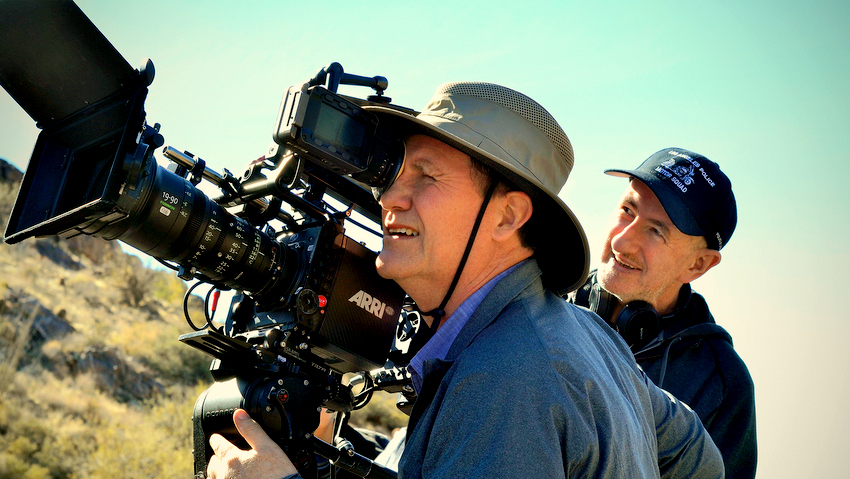
What was it like filming on location in Arizona?
AC: Arizona is an extraordinary locale; it provided us with an otherworldly vibe with its forests of saguaro cactus. The weather behaved and gave us five glorious days of sunshine and incredible sunsets.
Can you describe your storyboard process?
AC: Storyboarding is my playtime – it’s where I can be the most inventive, adventurous, and experimental without wasting production dollars.
Initially I read the script and as images form in my mind I sketch them out, then when I scout locations, I shoot various angles on specific lens sizes and sometimes use them as background plates for the storyboards which I then draw the characters onto.
Storyboards help get everyone on the same page, especially with action and VFX shots, which saves valuable production time. The trick is not to be a slave to them and keep yourself open to ideas as they are presented on the day.
I always listen to music when boarding. Music inspires me as to how certain sequences should be shot, sometimes a cue will help determine what the length of a visual sequence should be and that’s a great discipline for me.
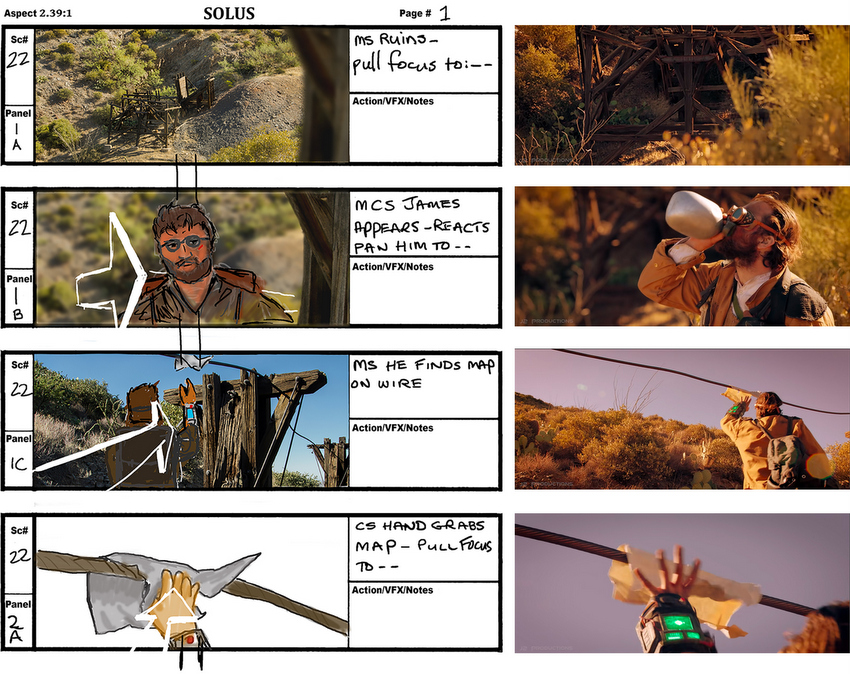
What was the most interesting part of filming this sci-fi pilot?
AC: The most challenging part of the shoot was filming halfway down a steep slope for the tramway ruins sequence. It was gruelling physically, but everyone delivered.
The most interesting part was creating the illusion that Jacob and Jordan were climbing a vertical cliff. I employed a variety of techniques, including the old Batman series trick of tilting the camera on its side and having the actors “crawl up” on flat ground; they sold the “climb”. The actors trusted Ross and myself and mimed the climb action convincingly. I corrected the far background with vertical terrain to further complete the illusion.
Our VFX wizards created the mountainous vista shots using meticulous rotoscoping which included tracking camera movement. No stuntmen or wire rigs were necessary.
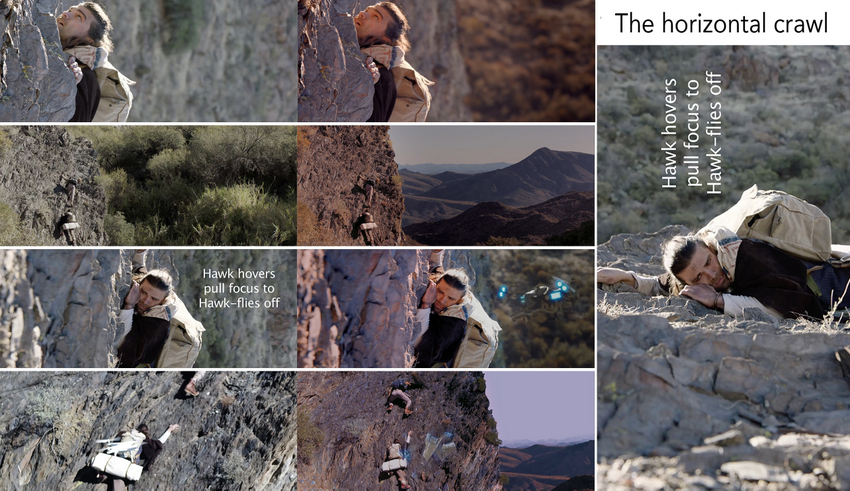
It seems that you were also the editor of SOLUS. Tell us about your editing process.
AC: As a director I employ my editing knowledge when planning my shots, I have the edit more or less mapped out so the editing process goes quickly and smoothly. When I edited features for other directors I would cut on location as material arrived each day.
When I edit the films I have also directed, I have the assistant prepare the data in scene order. I start at scene 1 and edit straight through which gives me a greater sense of continuity while assembling the story. It took about 2 weeks to complete a 45-minute assembly of Solus, which was close to the final length. I then begin the fine-tuning process and, for me, this is where the movie is made. A movie is written three times – on the page, during the shoot and in the final edit.
What other films have you directed and/ or edited?
AC: this is a placeholder text, that indicates that the content for this template must be placed between this block, to allow the article hold a firm structure and also kill time for the writer or editor.
Editor & 2nd Unit Director (Adrian Carr)
The Man from Snowy River (1982)
Quigley Down Under (1990)
D.A.R.Y.L. (1985)
The Lighthorsemen (1987)
Director & Editor (Adrian Carr)
Blood Makes Noise (2005)
Bonds of Brotherhood aka Tango Down (2017)
Adrian Carr (Playlist)
What do you hope audiences will get from the presentation of SOLUS?
AC: SOLUS was initially designed as a short film but was expanded to accommodate the concept for a series pilot. I hope I have taken the audience on a journey that has provoked questions, yet unanswered, with an ending that will make them want to see the next episode.
What are your future goals?
AC: My goals are to direct films that entertain, excite and move audiences and to provoke discussion.
Tell us about what you think that indie filmmakers need in today’s world of filmmaking.
AC: I think all indie filmmakers who want to tell narrative stories need to take acting classes, not necessarily to become an actor, but to understand what their process is, how to empathize with them, and to better communicate what they need from their actors. Work and work then rework the script until it’s the best it can be. With the plethora of digital recording devices available today there is nothing to stop a filmmaker from getting out there and just doing it.
What other projects do you have in the works?
AC: Yes there are three actually, the first is A Dolphin in our Lake, a fantasy drama set on a corn farm in Ohio back in the year 1942, and the second is Do it Scared a docu-drama featuring a Maltese-Australian Priest, Fr. Rob Galea, and the third is PeeksKill which is a supernatural horror thriller.
What advice can you offer to young filmmakers who are just starting out?
AC: Watch a ton of movies, read as many screenplays as possible, then meet like-minded filmmakers. Next, find or write a short script on a subject you are passionate about, nothing too grand, something on which you can exercise your skills and go make it. Screen it, post it, share it to get feedback then make another.
Tell us what you think of the interview “Meet Adrian Carr: The SOLUS Director Unveils his Mythological Sci-fi Adventure” What do you think of it? What ideas did you get? Do you have any suggestions? Or did it help you? Lets have your comments below and/or on Facebook or Instagram! Or join me on Twitter @oladapobamidele
Follow Adrian Carr on Social Media
IMDb
LinkedIn
YouTube
Richard Green Documentary, ‘I Know Catherine, The Log Lady’: Premiere in NYC, LA May 9th
Lynchian Doc I Know Catherine, The Log Lady Makes Hollywood Premiere 4/17, Rollout to Follow
In Camera by Naqqash Khlalid Launch on VOD April 29
Naqqash Khlalid’s Directs Nabhan Rizwan. In Camera stars an EE BAFTA Rising Star Award Nominee.
2025 Philip K. Dick Sci-Fi Film Festival Award Winners Announced
Vanessa Ly’s Memories of the Future Awarded Best PKD Feature
Dreaming of You by Jack McCafferty Debuts VOD & DVD for April Release
Freestyle Acquires “Dreaming of You” for April 15th Release
Hello Stranger by Paul Raschid set for London Games Festival & BIFFF
The film Is set for an April 10th Premiere at The Genesis Cinema in London (LGF) and BIFFF
Daydreamers Official Trailer by Timothy Linh Bui: Released by Dark Star Pictures
Daydreamers Vietnamese Vampire Thriller – May 2nd release









